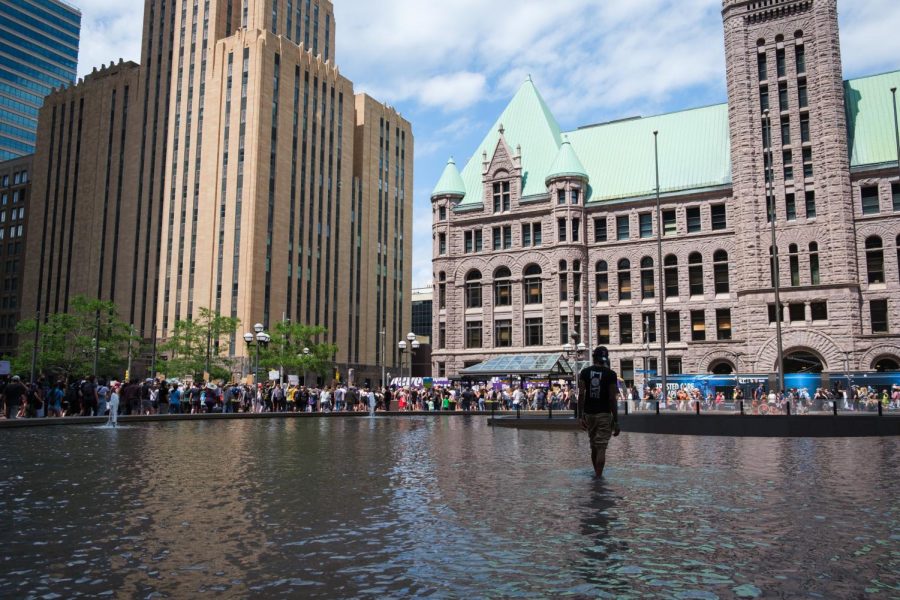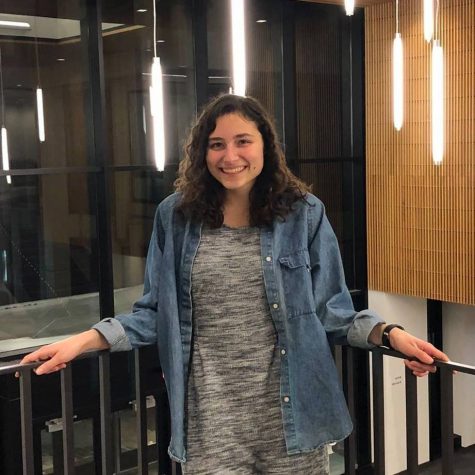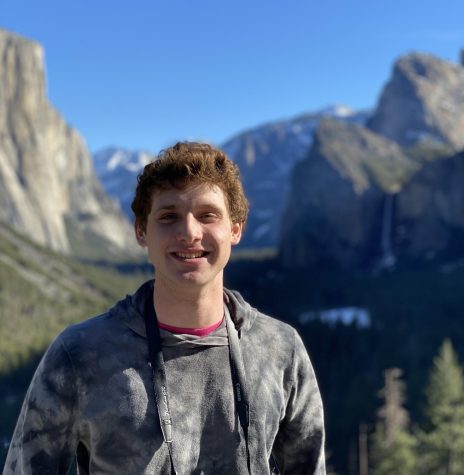Black Lives Matter, USA
Protesters march through Minneapolis on June 13th to demand justice for George Floyd and other victims of police violence. Photo by Kori Suzuki ’21.
June 30, 2020
Between Macalester closing its campus in March and the start of the summer break, many students found themselves watching from their hometowns as the Black Lives Matter uprising began in Minneapolis — a place many students consider a second home. Several Macalester students have turned to activism in their hometowns.
Over 2,000 cities and towns have held recorded protests in the last month — including demonstrations in 60 countries around the world. In the midst of the COVID-19 pandemic, the uprising has spilled over from Minneapolis to other major cities to small towns.
Washington, D.C.
Lafayette Square, just behind the White House, is always home to at least a few protesters. In the past few weeks, however, police, the National Guard and unmarked law enforcement officials dressed in riot gear fenced off streets a full block around the White House, silencing the square that is usually a demonstration hotspot.
Protesters in D.C. have instead gathered as close to the White House as they can get and marched through the streets of Capitol Hill. Gabby Whitehurst ’23 has been marching with them, joining various protests and car caravans.
Whitehurst has noticed a different atmosphere than she’s used to at D.C. protests. For one, the law enforcement presence has been higher than usual.
This unusually heavy police and law enforcement presence brought in officials from numerous jurisdictions — including the Drug Enforcement Agency and one group of unmarked uniformed officers who wouldn’t identify themselves to protesters.
Having protested in both D.C. and the Twin Cities before, Whitehurst believed that D.C. police would be better at monitoring protests without retaliating than the police in Minneapolis. But in the last weeks, she’s watched in person and on social media while police in both cities respond to protesters throwing water bottles with tear gas and rubber bullets.
“It’s a bit overwhelming,” Whitehurst said. “It’s also a reminder that we’re the only ones who have our backs right now, because the government clearly doesn’t.”
The heightened police presence isn’t the only thing contributing to tension in D.C. Whitehurst said that President Donald Trump’s response to the Black Lives Matter movement has been particularly inflammatory.
On June 1, in Lafayette Park, law enforcement suddenly and without provocation deployed tear gas on protesters so Trump could more easily cross the street for a photo at a nearby church.
“There’s a different energy right now, and I think that Trump’s rhetoric probably has something to do with it,” Whitehurst said. “He says so much stupid stuff that I think people forget that he actually has power and his rhetoric is extremely dangerous, so I definitely feel that coming through in these protests.”
While she’s been physically present at the D.C. protests, Whitehurst has stayed connected to the Macalester and Twin Cities communities, too. As a vice president of the Macalester Black Liberation Affairs Committee (BLAC), Whitehurst has met virtually with Macalester President Suzanne Rivera and been involved with Black Lives Matter at Macalester.
Whitehurst is working from home with these groups to examine Macalester itself.
“We’re trying to figure out how higher education… can be decolonized,” Whitehurst said. “So we’re just trying to see what measures we can take to bring Black Lives Matter into the classroom and bring radical love and healing into the classroom.”
Whitehurst said that her parents and grandparents are skeptical of the change this moment might bring. They’ve seen social movements like this in their lifetimes without seeing many tangible results.
But Whitehurst thinks this might really be when things start to change.
“I’m hopeful that we’re heading towards some bigger institutional changes here,” Whitehurst said. “I think people are recognizing that liberal reforms are not getting to the root of the problem and… people are wanting justice and not equity anymore, which I think is key.”
Omaha, NE
At protests around the country, demonstrators chant the name of George Floyd. In Omaha, another name has been echoing through the streets: James Scurlock, the 22-year-old Black man killed by a white bar owner during protests on Saturday, May 30.
Since then, Scurlock’s name has filled hashtags, chants and protest signs in Omaha. Mayor Jean Stothert imposed a curfew for several nights after the murder.
Much like Minneapolis, Omaha isn’t known for being a hotspot for protest and activism. But Betsy Foy ’22 wasn’t surprised when her hometown erupted in anger. Like Minneapolis, Omaha has an ongoing struggle with racism — historic discriminatory housing policies and segregated communities have led to high poverty rates among Black residents and wide racial gaps in education.
It’s also the birthplace of Malcolm X, and in the past weeks, protesters have gathered there for memorial services.
“It feels like there’s something happening in Omaha that isn’t being seen by a lot of the world,” Foy said. “There’s so much going on, and I just hope that in Omaha we don’t let this die down.”
On the afternoon of Friday, May 29, she joined demonstrators in a busy area of downtown Omaha for a peaceful demonstration. In the evening, though, police started using tear gas and pepper bullets when protesters began blocking traffic.
Foy said she stayed for about two hours after the police began retaliating. By the time she left, she had been separated from her friends and couldn’t see through the tear gas.
Joining the activism in Omaha felt like a way to contribute to a movement that began in Minneapolis. Seeing the protests break out in the Twin Cities drove the issue home for Foy.
“St. Paul has become my home over the past two years, and it’s a place that I love and I really wish that I could be there in person supporting,” Foy said.
Oshkosh, WI
When Amber Widenhoeft ’23 went to a Black Lives Matter march in Oshkosh, Wisconsin, she didn’t expect to see a huge turnout. Her hometown isn’t particularly large, diverse or liberal.
But hundreds attended a demonstration there on May 31.
“I was very surprised and proud of the amount of people who came to the protest,” Widenhoeft wrote in an email to The Mac Weekly. “Lots of chants were shouted as we marched down Main Street and around several other city blocks.”
The presence of police, often hostile, has been a key characteristic of these past few weeks of protests. In Oshkosh, the police were very clearly present, but not openly antagonistic. Widenhoeft told The Mac Weekly that several police cars blocked off streets near the march’s path.
However, several counter-protesters attended the event and attempted to disrupt the rally.
“I would say maybe 10 or so [counter-protesters]…were just wearing American flags and maybe carrying a sign,” Widenhoeft wrote. “Some of the people in contradiction were taking pictures of the protest or talking to the police… one man was yelling insults into the crowd when we were marching and a girl marching just yelled back at him and basically cussed him out.”
But Widenhoeft thought the goals of anti-racist marchers still came through loud and clear.
“I think the huge crowd may have intimidated [the counter-protestors],” Widenhoeft said. “I think a lot of the BLM protesters didn’t even notice the counter-protesters because they didn’t make themselves obvious.”
Ultimately, Oshkosh’s protest occurred without much of a hitch. Widenhoeft had a positive outlook on her city’s experience.
“I was happy to see that so many people cared and were willing to fight for justice even during a time when many are scared to leave their homes,” Widenhoeft said.
Los Angeles, CA
For the past several weeks, Andrew Lee ’23 has been protesting the many charges of police violence against the Los Angeles Police Department (LAPD).
“As of June 11th, there have been 56 official misconduct complaints [against the LAPD], 28 of which refer to excessive use of force [since protests began],” Lee wrote in an email to The Mac Weekly.
The city’s Police Chief Michael Moore has received intense criticism for authorizing police to use less-lethal weapons on protesters. Moore has ignored other allegations of police misconduct, increasing public pressure against him.
Lee has experienced some of this force first-hand. At a protest he attended on May 30, police launched tear gas and rubber bullets at participants. Lee couldn’t tell what the cause was.
“The protest was well within our rights,” Lee said, “From where I was, I could see absolutely no violence on behalf of the protestors.”
Although Lee was unharmed, he saw several other protesters sustain injuries from those same weapons. Across the city, the police exercised force, cracking down on demonstrators, peaceful or otherwise.
Los Angeles has an established network of activists that have been fighting for racial justice and were able to generate massive turnout for these demonstrations.
“In LA, we are lucky to have amazing organizations like BLM-LA, Build Power, and the Youth Justice Coalition, who have been organizing around these issues for years,” Lee wrote.
Activists have focused on some key demands: defunding the LAPD and removing Moore and L.A. County’s District Attorney Jackie Lacey from office. Lee told The Mac Weekly that a 5-mile “defund the police” march in Hollywood on June 7 that he participated in had 20,000 to 25,000 people in attendance, including families.
That is only a small portion of the action in L.A., however. Lee has seen daily marches and rallies, as well as city council meetings on Zoom where activists can promote their agendas.
“The energy in the streets is nowhere near out,” Lee said.
Aside from marching and joining Zoom meetings, Lee has committed to further educating himself on police abolition, citing Angela Davis as a scholar he’s currently reading. Summarizing the movement for police abolition that activists in LA and indeed around the country are fighting for, Lee put it simply.
“The goal is police abolition with an inevitable end to the carceral state.”
Clearwater County, MN
In Clearwater County, less than 300 miles northwest of Minneapolis, things have been distinctly quiet.
Maija Hecht ’21 was struck by the veil of normalcy in her hometown.
“People weren’t even talking about it,” Hecht said. “If they were talking about it, they were just talking about people burning things down and the economic effects of it in the Twin Cities, and talking about [COVID-19] and not at all about the conversation… about Black lives.”
Hecht has been living with her parents for a few months since she unexpectedly returned home early from her study away program in Argentina. In early June, she made the move back to St. Paul. This spring was the first time in a long time that she’d really lived at home.
So being there was strange for her even before the police killed George Floyd and the current movement for Black lives ignited in Macalester’s backyard. At that point, Hecht said, she felt powerless.
“It felt like being displaced from where most of the people that I care a lot about are,” Hecht said.
Like many others, Hecht found herself stuck in the constant social media scroll, spending hours skimming news updates, watching live streams and texting friends in the Cities. It was hard to look away from the movement.
“There’s so much energy that you can feel, and it feels like something that’s been building up for a long time has broken,” Hecht said. “But it induces a lot of anxiety because you know that it’s a really unstable situation. No one knows what’s going to happen next… things are changing so fast that you feel like you just need to help, but being so far away, I couldn’t.”
So Hecht tried to help from home. Part of that meant bringing a discussion of the movement to her quiet hometown.
“That was a conversation I had a lot with my family,” Hecht said. “That was just a really big argument in our house for the week and a half up until I left… my family’s pretty conservative.”
Hecht saw another opportunity to pitch in to the movement effort. A few days before she left for the Twin Cities, she noticed posts on social media offering to drive supplies into Minneapolis, where food deserts have appeared and intensified with store closures.
“I didn’t really know what else I could do at the time, but I have a car and I had the resources to do that,” Hecht said.
She put out a call for donations on social media and raised about $400. Before moving, she headed to the Bemidji, MN Walmart and cleaned out their supplies of bras, pads, saline solution, bandages, waterproof tape and burn cream.
Once she got back to the cities, she brought it all to a donation center in North Minneapolis, driving past National Guard vehicles, spray-painted murals on plywood and gatherings of volunteers.
“It’s definitely not like normal,” Hecht said. “It’s really strange.”
Protests have slowed in pace somewhat since the first week or two following Floyd’s death. Public transit is running on its usual hours again. Shops in some areas of the city have taken the plywood boards off their windows. But Hecht hopes that people keep working, and that that work is remembered.
“A month or so from now, anyone that’s not from the Twin Cities is going to look at media stories on the aftermath of this… [is] going to be able to chalk it up to one idea of what a protestor has been — why they were there, what they wanted, what they were saying,” Hecht says.
She hopes that doesn’t happen. Along with leaders of BLAC, Hecht is working on establishing a database of photos and personal stories to record the experiences of those involved in these protests.
“I don’t want to lose all of the individual experiences that happened while this was going on,” Hecht said.
Additional thanks to Daniel Woodward ‘23 who spoke to The Mac Weekly and provided information for this story.















